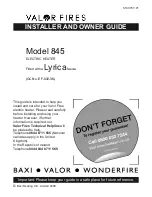
8
Installation Instructions and Owner’s Manual
Unvented Natural Gas Fired Room Heater
through 4 under Attaching to Wall using Anchor.
If installing bottom mounting screw into wall stud,
drill holes at marked locations using 9/64” drill bit.
5. Re-place heater onto mounting bracket.
6. Place spacers between bottom mounting holes and
wall anchor or drilled hole.
7. Hold spacer in place with one hand. With the other
hand, insert mounting screw through bottom
mounting hole and spacer. Place tip of screw in
opening of wall anchor or drilled hole.
8. Tighten both screws until heater is firmly secured
to wall. Do not over tighten.
Note: Do not re-place front panel at this time.
Replace front panel after making gas connections and
checking for leaks.
FLOOR MOUNTING AWAY FROM WALL:
Installing Support Feet (See figure 11.)
1. Lay heater onto table on its back with bottom
edge overhanging table edge.
2. Securely attach feet to bottom of heater using 2 –
self-tapping screws each.
Figure 11
Note: Feet should have long end going out the front of
heater, and the edge coinciding with side of heater. If
feet overhang side of the heater, switch leg location.
3. Place heater on non-combustible surface (see
Locating Heater, page 6) before proceeding
with gas connection. If this will be a permanent
location, heater may be locked into position using
anchoring holes in mounting feet.
Note: Use of floor mounting feet will require you to use
a 3/8 NPT street elbow to make gas connection.
CONNECTING TO GAS SUPPLY
WARNING:
A qualified service person must connect
heater to gas supply. Follow all local codes.
WARNING:
This appliance requires a 3/8” NPT
(National Pipe Thread) inlet connection to the pressure
regulator. Use of floor mounting feet will require you
to use a 3/8 NPT street elbow to make gas connection.
CAUTION: Never connect heater to private (non-utility)
gas well. This gas is commonly known as well-head
gas.
IMPORTANT: Check your gas line pressure before
connecting heater to gas line. Gas line pressure must
be no greater than 14 inches of water. If gas line
pressure is higher, heater regulator damage could
occur.
CAUTION:
Use only new black iron or steel pipe. Internally-
tinned copper tubing may be used in certain areas. Check
your local codes. Use pipe of large enough diameter to
allow proper gas volume to heater. If pipe is too small,
undue loss of pressure will occur.
Installation must include an equipment shutoff valve, union
and plugged 1/8” NPT tap. Locate NPT tap within reach of
test gauge hookup. NPT tap must be upstream from heater
(see figure 12).
*A CSA/AGA certified equipment shutoff valve with
1/8” NPT tap is an acceptable alternative to test gauge
connection. Purchase the CSA/AGA certified equipment
shutoff valve from your dealer.
IMPORTANT:
Install an equipment shutoff valve in an
accessible location. The equipment shutoff valve is for
turning on or shutting off the gas to the appliance.
Apply pipe joint sealant lightly to male threads. This will
prevent excess sealant from going into pipe. Excess sealant
in pipe could result in clogged heater fuel train.
CAUTION:
Use pipe joint sealant that is resistant to
natural gas.
Install sediment trap in supply line as shown in figure 12.
Locate sediment trap where it is within reach for cleaning.
A sediment trap traps moisture and contaminants. This
keeps them from going into heater. If sediment trap is
not installed or is installed improperly, heater may not run
correctly.
IMPORTANT:
Hold pressure regulator with wrench when
connecting it to gas piping and/or fittings.


































